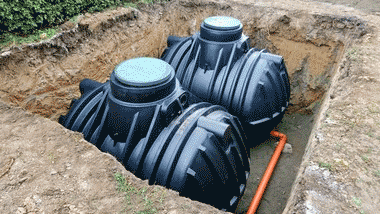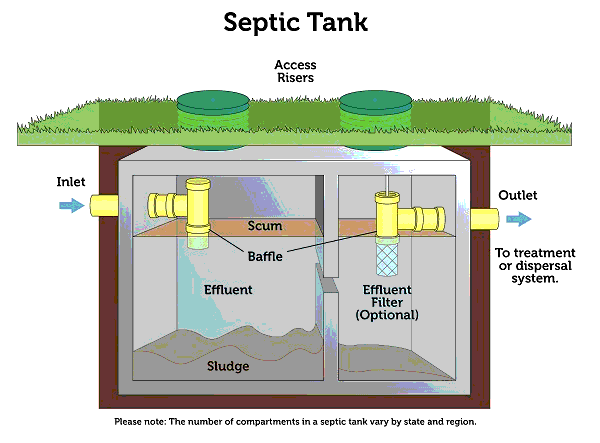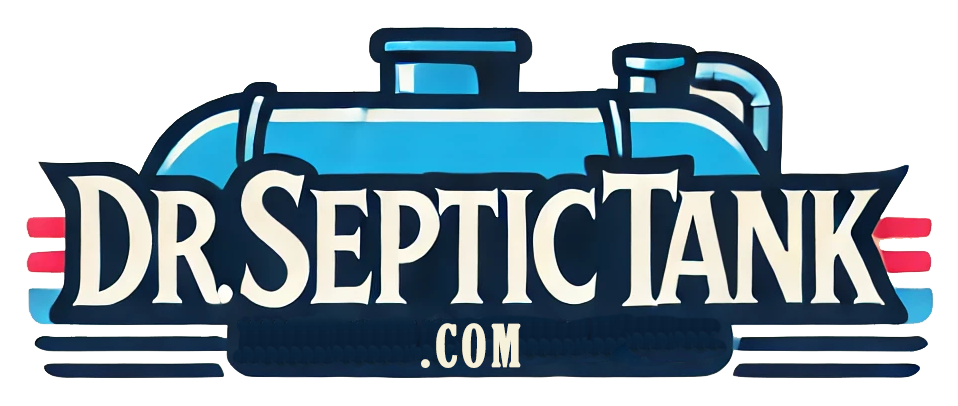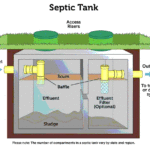
A septic tank is an underground, watertight container typically made of concrete, fiberglass, or polyethylene designed to receive and partially treat raw household wastewater. In the tank, heavy solids settle at the bottom, while grease and lighter solids float to the top. The solids remain in the tank, and the treated wastewater is discharged to the drainfield for further treatment and dispersal. It is a crucial component of a septic system, which is a small-scale sewage treatment system commonly used in areas without centralized sewer systems.

Components of a Septic Tank System
Septic system is more than just a tank. It’s a carefully designed network of components working together to manage your wastewater effectively. Let’s break down the main parts:
1. The Septic Tank: This is the heart of the system. Usually made of concrete, fiberglass, or polyethylene, the tank is a large, watertight container buried in your yard. It’s where the initial separation and decomposition of waste occurs.
2. Inlet Pipe: This pipe carries wastewater from your home into the septic tank. It’s like the entrance to your wastewater’s journey through the treatment process.
3. Outlet Pipe: Also known as the drain field pipe, this component carries treated effluent from the septic tank to the drain field.
4. Drain Field (or Leach Field): This is an area of perforated pipes buried in gravel-filled trenches. It’s where the final treatment of wastewater occurs as it slowly filters through the soil.
5. Soil: The soil around your drain field acts as a natural filter, removing harmful bacteria and nutrients from the wastewater before it reaches groundwater.
Key characteristics of a septic tank:
- Size: Usually ranges from 750 to 1,250 gallons for a single-family home
- Shape: Typically rectangular or cylindrical
- Compartments: Often divided into two main compartments
- Inlet and outlet pipes: For wastewater to enter and exit the tank
Brief Overview of a Septic Tank’s Purpose
The primary purpose of a septic tank is to safely dispose of household wastewater and prevent contamination of groundwater and surface water sources.
Main functions of a septic tank:
- Collection: Receives all wastewater from household plumbing fixtures (toilets, sinks, showers, washing machines).
- Separation: Allows solid waste to settle at the bottom (forming sludge) and oils and grease to float to the top (forming scum).
- Decomposition: Facilitates the partial breakdown of organic matter by bacteria in an anaerobic (oxygen-free) environment.
- Effluent discharge: Releases partially treated wastewater (effluent) into the drain field for further natural treatment.
By performing these functions, septic tanks play a crucial role in:
- Protecting public health by safely managing human waste
- Preserving local ecosystems by preventing untreated sewage from entering water bodies
- Recharging groundwater through the slow release of treated effluent
Here’s a great video from our friends from ask this old house.
How Septic Tanks Differ from Municipal Sewer Systems
- Location and Ownership: Septic tanks are on-site systems, typically owned and maintained by the homeowner. Municipal sewers are centralized systems owned and operated by local governments.
- Treatment Process: Septic tanks treat wastewater on-site using natural processes. Municipal systems transport wastewater to large treatment facilities for processing.
- Maintenance Responsibility: With a septic tank, you’re responsible for regular maintenance and pumping. Municipal sewer users typically pay a fee for maintenance handled by the local authority.
- Environmental Impact: Properly maintained septic systems can be more environmentally friendly, as they recharge local aquifers. However, failing septic systems can pose significant environmental risks.
- Cost: While septic systems have higher upfront costs and ongoing maintenance expenses, they can be more cost-effective in the long run compared to ongoing municipal sewer fees.







